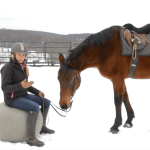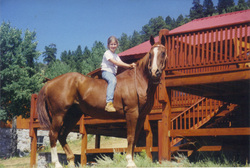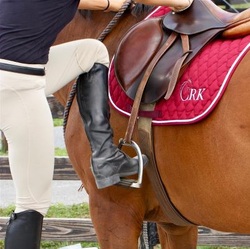The sitting trot is one of those gaits that most of us want to improve. To sit the trot smoothly and comfortably takes a combination of balance, stability, and fluid movement.
When I ride and when I teach riding, I am always looking for what really makes the difference in learning a new skill. Whether it is a descriptive word or an analogy that creates a new understanding, or an exercise that helps create the right feeling. Many times, in the process of searching for a better way, I realize that what I was doing really didn’t work all that well. This is what happened with the sitting trot.
When I was introduced to a new way of not only riding the sitting trot, but also a new way of describing how to sit the trot, not only did my own riding improve, but I was also able to do a better job helping my riding students improve their trot.
It was a simple shift from thinking about absorbing the movement of the sitting trot to going with the movement of the sitting trot. I explain what I mean by this in today’s video, as well as share a simple exercise to help your own riding.
Now it’s your turn to leave a comment! What helped you better ride the sitting trot? Was it a new way of thinking about it? A word someone used? An exercise?
See you in the comments!
Callie















37 Responses
Thanks Callie, looking forward to practising!! Thank you for the video in such cold conditions (plus a seat warmer!) – hard to comprehend the temp from Australia…
It was pretty cold! But this jacket I am wearing is heated, so that helps a lot!
Thank you Callie for this nice presentation. Particularly the part with the repeated transitions from walk to trot and trot to walk is useful, easily to apply, and best of all: you get familiar step by step
with the halfparade.
Nice, clear, clean, helpful presentation.
Nice video, Callie. I’ve tried to go with the lateral movement, but I like the idea of lightening up and going with the “jump.” Thanks for yet another helpful video!
Very helpful! I’ve sort of felt like different people lately…when I ride my friend’s horse once a week I have absolutely NO feedback plus he is super lazy with a very slow trot and then at the other barn where I have an intense lesson I’ve been shuffled from a dressage teacher to one more attuned to hunter/jumper style so I’ve been feeling like I get mixed messages. Hope I can show this to my Pilates instructor and maybe she can watch me to see if I’m engaging the correct muscles on the ball. Even if that doesn’t happen you always give me something to think about implementing as I try to be a more confident, securely-seated rider! You’re the best!
Hi Cheryl, I am excited to hear what your pilates instructor says! I mentioned this on the video, but it was something my own pilates instructor said during a class that helped me figure out which muscles to use. She used the analogy of the vertebra of my lower back being “tuna fish cans” and to think about lifting those cans off of one another, one can at a time… it really helped me find the deeper core muscles need for stabilization!
Hi Callie, thanks a lot for this video. I’m a rather small woman (1,63m), but my horse is a huge 1,80m Hanoverian with, of course, huge strides which are causing me trouble in both trotting and galloping. And I have to admit I make all three mistakes you described… I had one teacher telling me to concentrate on keeping my knees tight to the saddle, which made me bounce even worse. The next one told me to make sure I focus on my stirrups (which I lost quite often then – any hint you could offer for that topic?), but this made me feel “blocked” in my legs and my hips. And then someone else told me to practice riding trot without stirrups, which then made me feel so much out of balance I started dropping forward, pulling my shoulders in… Now after watching your video I’m really exited to see how your tips will work for me 🙂
Hi Birte,
I see your comment now!
It is hard when different people give you conflicting advice. I find that riding without stirrups and only trotting for a short time is the best way to learn the sitting trot. If you keep trotting, you will inevitably lose your balance and then feel that rolling forward feeling that you described as you try to find your balance again. Only trotting for short periods tends to keep the horse slower and makes it much easier to stay balanced.
The main thing with your legs is to not focus on anything too much. What I mean by that is you want to just relax and think about the movement. So try walking around a bit before you trot and shake out each area of your body. Lift your legs up and down, roll your ankles slowly, shake out your arms… until everything feels relaxed but engaged. Meaning you don’t want to think so relaxed that you are just slumped over the saddle. Then try your trot. If you get tight and grippy, stop and walk for a moment letting everything relax again. Try not to think about anything except the movment of the horse’s back.
I hope this helps, let me know how it goes!
Hi Callie,
Thank you so much for the video, i always do the sitting trot without stirrups and i found it much easier and it helped me alot, i appreciate if you can help me to improve cantering and the two point position as i find so much difficulty to do them
Thanks
This is a great video. I’ve really been working on getting my sitting trot more fluid. Your advice to do transitions (walk, trot, walk, trot, etc.) is what I needed to hear. I’ve noticed that my horse starts to really get choppy and animated during the sitting trot, so I give up and just start posting. I realized I’ve probably started bouncing and she has rounded up her back to avoid the bounces. Thanks for such a clear and concise presentation. You are an amazing teacher and trainer.
Thank you, Maureen, glad you enjoyed the video!
Thanks very much Callie! Very nice presentation,… and the concept of riding ‘with’ the movement of the trot rather than attempting to ‘absorb’ the trot makes intuitive sense. I am able to sit the trot on some horses,… and on others (including my own horse) it is a struggle. I think that when I attempt to “absorb” the movement of the trot I end up “bracing” myself (my horse has a lot of suspension in his trot),… which in turn invites a brace from him where he hollows his back and raises his head,… which compounds the “brace” for both of us,… and I abandon the sitting trot for a posting trot,…. Now, with the “picture/thought” of moving ‘with’ my horse,…. things may improve (for both me and my horse).
Thank-you again for your helpful and inspiring videos!!
Hi Callie
Thank you so much for this video
You explained it so well. This is come thing I am also struggling with.
I seem ok at first but the more I do the more I seem to lose my balance especially on corners.
Doing lots of transitions and building it up really sounds great. Can wait to try it out.
Thanks again for another great video
Nicola in dublin ireland
Excellent. Thank you. Mary Wanless describes how the rider should “plug in” while riding a sitting trot. Your explanation of going with the movement makes so much sense. Combine these thoughts and perhaps I will actually be able to get even just a few nice steps. Also, this was a super picturesque video! ❄️
Thanks Emma! The snow did make the video look really pretty 🙂
Callie: thank you for your work! I learn a great deal from you ALWAYS!
When you were explaining the “old” way you would sit the trot, I completely understood because I would do the same thing….straighten the back by tucking my pelvis under & up & tighten my lower abdominal muscles to sit deeper. This worked in a slow trot, but not a faster, bigger one…just as you said. Can you help me to better understand the “new” way to sit the trot…please
Something more descriptive as to what I’m to do with each body part… The way you described the “old” way would be really helpful. Thank you!!!
Hi Jane, thanks for your comment! Think about keeping everything neutral, pelvis in a position as though you were standing comfortably, lower back lengthened – try watching this video on breathing to help get the feeling in your lower back. Upper body tall but loose, expanding your chest through good breathing instead of shoulders pulled back. During the trot think about the muscles in your deep core – these provide the stabilization you need without making things stiff like what can happen when we tighten more external muscles. Picture the movement of the trot going throgh you and out the top of your head (sounds wierd, but works for me) instead of stopping in your hips. Finally, give it some time to work, this may not create a sudden “light bulb” feeling but will start to feel better with more rides. Hope this helps! Callie
Very helpful video Callie. Thank you. I’ve just bought a yoga ball so will go with this exercise which I’m sure will be most beneficial. I have also started doing a few walk/trot transitions without stirrups in each lesson and my sitting trot is improving enormously as is my confidence.
Have to say that the picture quality of this video is brilliant and the lovely Molly looks delightful in her winter coat!
Yvonne.
Hi Yvonne, Thanks and enjoy your yoga ball! There are so many fun riding related exercises you can do on these!
Wonderful video….I appreciate the detail in your explanation and riding examples. I’ll give it a try next time I ride. Thank You!
I want to order Ecoliscious products. Can you tell me where I can do this. It says I can order from your website but I can’t find a place to order?
Here is the link: http://hbsecolicious.weebly.com/
Callie, thank you for all your great teaching videos . It was so helpful to see how you rode both ways and how you/I sit when doing the “Big 3 Mistakes”. My instructor frequently reminds me to sit taller and more open, and your video strengthens the message.
Callie, I meant to post a response weeks ago! Thanks for the video and insight. But you know what worked for me? Remembering to keep my back straight and my seat bone under me. Hollowing my back led me to push my seat bone behind me, while shortening my back and making it difficult to balance myself at the sitting trot.
Thanks for sharing Michelle!
Hey!
I have a problem with steering while doing the trot(posting and sitting).
Can you please make a video on it?
Hi Julia,
Thanks for the suggestion! I would say work on the steadiness and independence of your seat – basically work on being able to sit the trot or post the trot without having to think about what you are doing. A good way to practice this is on a lunge line, where you can completely drop the reins as someone else has control of the horse. When riding these gaits with your body becomes more natural then the steering should come easier as well!
Callie, I want to thank you for all of the work you put into your videos. I watch them and apply your techniques to supplement and reinforce the work from my own instructor. It helps to sit back, slow down and absorb the information when you are not on the back of a horse. Your advice on the sitting trot has helped me improve quite a bit, especially learning how to relax and not struggle to maintain balance. My current issue has more to do with the signals and transition to a canter. When I attempt to signal for canter with my leg and hands I tend to lose my balance with the sitting trot and this confuses the horse. Any siggestions or just more and more practice? Again, many thanks for your efforts, they are appreciated.
Thanks Ian, glad you are enjoying the videos!
One tip I could give you for the canter transition is to think about going from the movement of the trot into the movement of the canter with your body. It sounds funny, but usually when a rider loses balance in a transition its because as they are thinking about using their leg or hand for a cue, their body gets stiff. So think keeping the movement (of the trot, then the canter) through your body as you ask for the transition. Hope this helps! Callie
Hi Callie,
your videos are wonderful! Easy and clear explained! I admire your softness with your horse. How do you signal to go from walk to trot and to stop? It is as if you don’t do anything. Looks beautiful and peaceful. Thanks, Nadia
Excellent Instruction and detail. Thanks Callie!!
This is a great explanation and I am getting better at sitting at a trot. using the ball has helped as well as breathing into the lower back.
Callie,
Awesome video and awesome replies to the comments above. You say in the video, “support your back”. Wondering if you can describe that a bit more.
Hi Kathy, click here to watch a video to help you better understand this idea!
-Julia Burdy, CRK Training Community Manager
A couple of years ago, I began competing in Western Dressage and, Callie, the instruction you describe in your video has helped me quite dramatically. Not only does my horse feel my tempo in a much more tangible way, he is off the forehand and becoming more balanced. It all is leading to moments of beautiful self-carriage. I just love it.
Awesome Mark, you should be so proud of this progress!
– Julia, CRK Training Community Manager